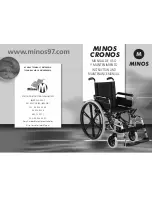
SAFETy TIPS
The engineering and construction of this wheelchair have been designed to provide maximum safety. International
safety standards currently in force have either been fulfil1ed or exceeded. Nevertheless, users may put themselves
at risk by improperly using their wheelchairs. For your own safety, the following rules must absolutely be
observed.
Unprofessional or incorrect adaptation or adjustment work could increase the risk of accidents.
As a wheelchair user, you are also part of the daily traffic on streets and pavements, just like anyone else.
We would like to remind you that you are therefore also subject to any and all traffic laws.
For this reason, you should always wear clothing which is light-coloured when it is dark, so that you can be seen
more easily. Also, make sure that the reflectors are not covered.
Be careful during your first ride in this wheelchair. Get to know your wheelchair.
Test what effect changing the centre of gravity would have on your wheelchair.
Practice using your wheelchair on level ground as well as going uphill and downhill.
TRANSPORTATION IN VEHICLES
This product is suitable to use as a seat in vehicles as per certificate
ISO/FDIS 7176-19 :2001 (E
) and using the
restraint system
Q straint Q-5001-T2
.
A wheelchair secured in a vehicle will not provide the equivalent level of safety and security of a vehicle seating
system. It is always recommended that the user transfers to the vehicle seating. It is recognised that this is not
always practical for the user to be transferred and in these circumstances where the user must be transported
whilst in the wheelchair the following advice should be followed.
1. Confirm that the vehicle is suitably equipped to transport a passenger in a wheelchair, and ensure the method
of access/egress is suitable for your wheelchair type. The vehicle should have the floor strength to take the
combined weight of the user, the wheel chair and accessories.
2. Sufficient space should be available around the wheelchair to enable clear access to attach, tighten and
release the wheelchair and occupant tie down restraints and safety belts.
3. The occupied wheelchair must be located in a forward facing position and secured by the wheelchair tie down
and occupant restraint straps (WTORS tie downs) meeting the requirements of ISO 10542 or SAE J2249, in
accordance with the WTORS manufacturers’ instructions.
4. The wheelchair’s use in other positions within a vehicle has not been tested e.g. transportation in a side facing
position must not be carried out under any circumstances. (Fig. 10)
warning
There is a risk of serious injury or death if this if this advice is ignored.
5. The wheelchair should be secured by a Tie Down Restraint system, conforming to ISO 10542 or SAE J2249
with non-adjustable front straps and adjustable rear straps, which typically use Karabiner clips/S hooks and
tongue and buckle fittings. These restraints generally comprise of 4 individual straps that are attached to each
corner of the wheelchair.
6. The tie-down restraints should be fitted to the main frame of the wheelchair as indicated in the diagram on
the following page, and not to any attachments or accessories, e.g. not around the spokes of wheels, brakes
or footrests.
7. The tie–down restraints should be attached as close as possible at an angle of 45 degrees and tightened
securely in accordance with the manufacturer’s instructions.
8. Alterations or substitutions must not be made to the wheelchair securement points or to structural and frame
or components without consulting the manufacturer. Failure to do so will invalidate the ability of a Sunrise
Medical wheelchair to be transported within a vehicle.
ENGLISH
18
19
Summary of Contents for Breezy 200
Page 2: ...2 Fig 2 Abb 2 Fig 3 Abb 3 Fig 4 Abb 4 1 2 3 7 10 9 8 5 6 Fig 1 Abb 1 4 ...
Page 3: ...3 ...
Page 4: ...4 ...
Page 5: ...5 ...
Page 84: ......
















































